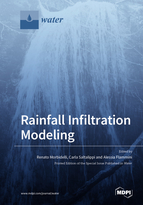Rainfall Infiltration Modeling
A special issue of Water (ISSN 2073-4441). This special issue belongs to the section "Hydrology".
Deadline for manuscript submissions: closed (28 February 2020) | Viewed by 39135
Special Issue Editors
Interests: water resource management; hydrological modeling; hydrology; hydrologic and water resource modeling and simulation; water balance; watershed hydrology; surface hydrology; watershed management; evapotranspiration; rainfall runoff modelling; flood modelling; rainfall; soil physics; watershed modeling; surface water; hydrological data management; evaporation; climate change and water; time domain reflectometry (TDR)
Special Issues, Collections and Topics in MDPI journals
Interests: hydrological modeling; hydrology; water engineering; watershed hydrology; surface hydrology; rainfall runoff modelling; flood modelling; rainfall; open channel hydraulics; river engineering; time domain reflectometry
Special Issues, Collections and Topics in MDPI journals
Interests: environment; water resource management; soil; hydrological modeling; hydrology; environmental engineering; water balance; watershed hydrology; meteorology; precipitation; rainfall; time domain reflectometry
Special Issues, Collections and Topics in MDPI journals
Special Issue Information
Dear Colleagues,
Rainfall infiltration is an important part of the physics of the hydrologic cycle and plays a crucial role in the formation of surface runoff, providing subsurface water that governs the water supply for agriculture, the transport of pollutants through the vadose zone and the recharge of aquifers.
The spatio-temporal evolution of the infiltration rate under natural conditions cannot be currently deduced by direct measurement at any scale of interest in applied hydrology, therefore the use of infiltration modeling that allows it to be described through measurable quantities is of fundamental importance.
In spite of the continuous development of infiltration modeling, the estimation of infiltration at different spatial scales, i.e. from the local to the watershed scale, is a complex problem because of the natural spatial variability of both soil hydraulic characteristics and rainfall.
For many years, research activity has been limited to the development of local or point infiltration models for vertically homogeneous soils. However, in addition to deepening this modeling, other interesting open problems should be addressed, including the modeling of point infiltration into vertically non-uniform soils, infiltration over horizontal heterogeneous areas and infiltration into soil surfaces with significant slopes.
Prof. Renato Morbidelli
Prof. Carla Saltalippi
Dr. Alessia Flammini
Guest Editors
Manuscript Submission Information
Manuscripts should be submitted online at www.mdpi.com by registering and logging in to this website. Once you are registered, click here to go to the submission form. Manuscripts can be submitted until the deadline. All submissions that pass pre-check are peer-reviewed. Accepted papers will be published continuously in the journal (as soon as accepted) and will be listed together on the special issue website. Research articles, review articles as well as short communications are invited. For planned papers, a title and short abstract (about 100 words) can be sent to the Editorial Office for announcement on this website.
Submitted manuscripts should not have been published previously, nor be under consideration for publication elsewhere (except conference proceedings papers). All manuscripts are thoroughly refereed through a single-blind peer-review process. A guide for authors and other relevant information for submission of manuscripts is available on the Instructions for Authors page. Water is an international peer-reviewed open access semimonthly journal published by MDPI.
Please visit the Instructions for Authors page before submitting a manuscript. The Article Processing Charge (APC) for publication in this open access journal is 2600 CHF (Swiss Francs). Submitted papers should be well formatted and use good English. Authors may use MDPI's English editing service prior to publication or during author revisions.
Keywords
- Hydrology
- Infiltration process
- Overland flow
- Local infiltration modeling
- Areal-average infiltration modeling
- Non-uniform soils
- Layered soils
- Hillslope hydrology
- Saturated–unsaturated flow model
- Field and laboratory experiments








